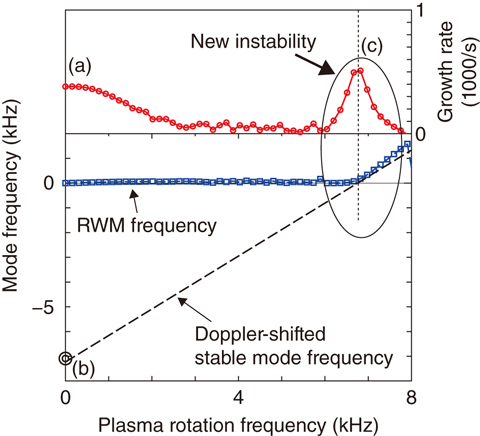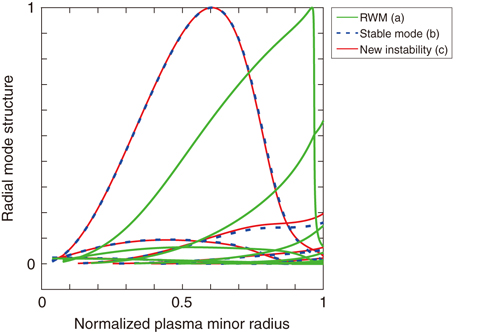
Fig.9-13 Dependence of growth rate and mode frequency upon plasma-rotation frequency

Fig.9-14 Radial structures of the Poloidal Fourier harmonics of RWM (a), the stable eigenmode (b), and the new instability (c)
To realize tokamak-type fusion reactors, achieving a steady-state burning plasma with high plasma pressure is necessary. Such high pressure is required to improve power-generation efficiency but sometimes triggers magnetohydrodynamic (MHD) instabilities that cause disruptive events. Hence, it is important to stabilize MHD instabilities by understanding the physics of their destabilization mechanism. Resistive wall modes (RWMs) are disruptive MHD instabilities that are destabilized owing to the finite resistivity at the vacuum chamber (wall) surrounding the plasma. The RWM has been confirmed to be stabilized by rotating the plasma in many experiments, but an MHD instability sometimes terminates the discharge disruptively, even though plasma rotation is kept sufficiently fast to stabilize the RWM. Hence, identifying the trigger of the MHD instability in a rotating plasma and determining how to avoid this instability are indispensable for realizing safe operation of a fusion reactor.
In this study, we analyzed the stability of MHD modes, including RWM, in rotating tokamak plasmas and discovered a new MHD instability. This instability is destabilized owing to the interaction between RWM stabilized by rotation and a stable MHD eigenmode (Fig.9-13). When a stable MHD eigenmode exists in a plasma, its eigenmode frequency can be modulated by rotation (Doppler shift). Conversely, since the RWM is excited by finite-wall resistivity, all RWM behavior is restricted by the wall. This means that the RWM frequency is always almost zero, even when a plasma rotates, because the mode is locked to the immobile wall. Hence, when the Doppler-shifted mode frequency of the stable mode approaches zero, this mode interacts with the RWM, exciting a new MHD instability. The radial-mode structure of this new MHD instability is almost the same as that of the stable MHD eigenmode, but is clearly different from that of RWM (Fig.9-14).
The newly discovered instability appears only when the frequency of the stable MHD eigenmode approaches zero owing to rotation. This mode frequency is determined by the magnetic configuration of the tokamak reactor, and the variation of the mode frequency is smaller than the maximum rotation frequency. Hence, it is possible to avoid this new MHD instability by adjusting the magnetic configuration to keep the eigenmode frequency higher than the plasma-rotation frequency.
The discovery of a new MHD instability owing to interaction between the MHD modes in plasmas is of importance from the physics point of view. In addition, a guideline on avoiding instabilities causing disruptive events is shown, as is required for designing tokamak fusion reactors safely and with high power-generation efficiency.
This work was supported by the Japan Society for the Promotion of Science (JSPS) KAKENHI Grant-in-Aid for Young Scientists (B) (No.24760712).